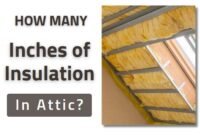Although spray foam is a relatively new means of providing home insulation, it can be used as a primary or secondary alternative to ensure your home has the proper R-value. The pros and cons of spray attic insulation are starting to become interesting topics to discuss.
Spray foam insulation is an air barrier that prevents air from passing through. Open-cell spray foam insulation can expand 100 times its original size, filling every nook and corner in the cavity where it is installed.
Best known as the most expensive choice among other types of insulation, here we will discuss spray foam attic insulation pros and cons.
Pros and Cons Of Spray Foam Insulation in Attic
Pros:
- When installed properly, spray foam insulation lasts longer than other types of insulation. Professional inspectors have given it a life expectancy of more than 80 years, with some alternatives rated for almost a century.
- Spray foam can help keep contaminants out of the attic. This advantage stems from the solid form of the insulation. Because it provides an impermeable barrier, you may find less pollen and other indoor contaminants, lowering the air quality. This benefit can also enhance the efficiency of your HVAC system, lowering your energy expenses in the long run.
- Because spray foam insulation is water-resistant, you can limit the amount of moisture that enters your attic during storms or as the seasons change. Unlike paper-insulated materials, you also don’t have to worry about the foam absorbing moisture and promoting mold, mildew, and fungal growth in your home.
- The R-value will not deteriorate over time. Because of the wear and tear it endures during its life cycle, fiberglass insulation frequently loses its R-value. Spray foam insulation gives you a unique experience. Even if it doesn’t provide enough insulation in some areas, the amount of heat that can be stored will not decrease with time.

Cons:
- One of the spray foam insulation for attics problems is it can be quite costly.
In some places, using regular fiberglass insulation in your attic would cost around 40 cents per square foot. If your R-value code demands you to use four inches of product to reach the right levels of energy efficiency, spray foam might cost you well over $6 per square foot in some areas.
Furthermore, if an issue is discovered during installation, you will incur additional charges to resolve it.
- This product will require additional curing time.
Spray foam insulation is not a product that can be installed and used immediately in your attic. You must allow it to grow and cure for it to provide the best possible protection for your home.
Spray foam makes your house unlivable for 24-72 hours until the product is complete because this product generates a gas during the procedure that might cause challenging physical symptoms with exposure, including breathing problems.
- Spray foam insulation poses a health risk for the installer person.
When applied correctly and given adequate time to cure, spray polyurethane foam (SPF) poses few risks. However, a hazardous reaction can occur if the person applying the insulation material does not wear personal protection equipment or if the foam is not applied properly.
When spray polyurethane foam is applied, fumes and aerosols are released, which can be harmful to the respiratory system.
Another health danger associated with spray polyurethane foam is the dust it can produce in the air; cutting and trimming the foam as it hardens releases chemicals into the atmosphere. The foam’s chemical composition contains isocyanates, a substance that can cause skin, eye, and lung irritation.
- Errors during installation may occur and the fixation is not easy.
When spray foam insulation is applied to a home’s attic, it is loaded with strange forms, gaps, and areas where air bubbles have the potential to form. The capacity of this insulation material to expand can help to lessen the likelihood of pockets in the installation, which can lower the R-value.
If this installation is not done properly, trapped air pockets can accumulate, causing the structure to shift over time.
The pros and cons of spray foam attic insulation show that it can be a cost-effective alternative in many homes worldwide. It all depends on what’s most important to you during the construction of your home.


